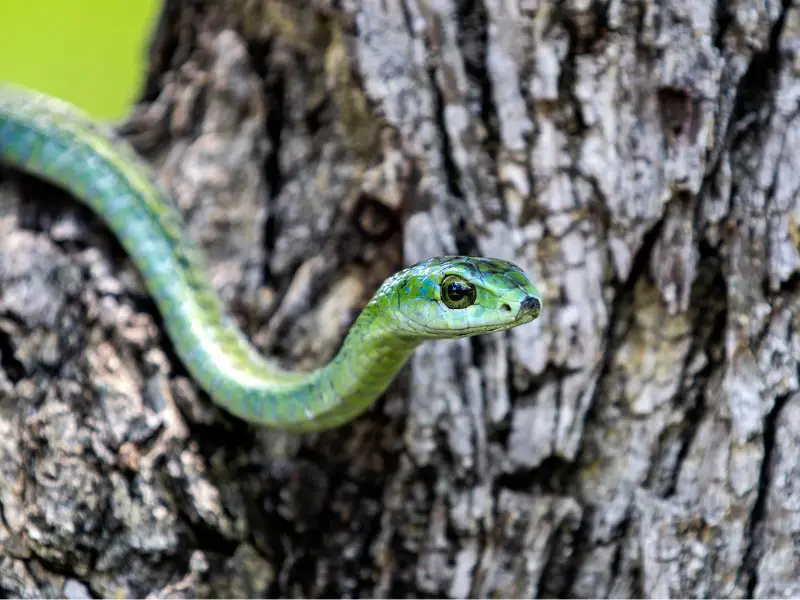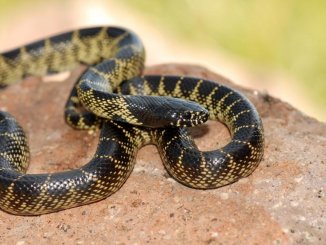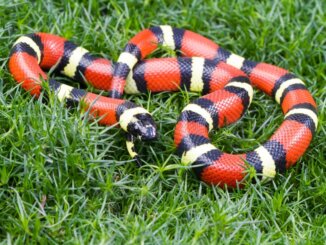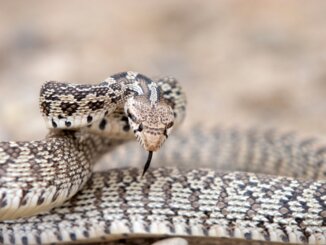The boomslang is an extremely poisonous yet shy, large-eyed, brown or green and black-blue snake in the Colubridae family from sub-Saharan Africa. Boomslangs are carnivores, diurnal, and dangerous animals that require advanced keepers who are experienced with dangerous reptiles. While not suitable as a pet, the boomslang is a fascinating and beautiful creature to know about.
Boomslang Snake Overview
| Common Name | Boomslang snake |
| Scientific Name | Dispholidus typus |
| Natural Habitat | Sub-Saharan Africa |
| Adult Size | 3–6 feet |
| Average Lifespan | 8 years |
| Diet | Small mammals like birds or mice, eggs, reptiles, other snakes |
| Housing | Leave in natural habitat, or large enclosure with room to climb |
| Experience Level | Advanced |
Origin

The boomslang snake (Dispholidus typus) is native to sub-Saharan Africa. The boomslang isn’t rare in the wild, and many are found hunting in trees and on the ground in this snake’s natural habitat. The boomslang’s natural habitat includes grasslands, savannas, and other areas with lots of trees and shrubs for the snake to climb.
Appearance and Behavior
Boomslangs are unique rear-fanged, venomous snakes that appear in a range of colors, including green and brown. The males are typically green, blue-green, or brown-black, and females are a less-colorful brown. Young boomslang snakes take a couple of years to gain all of their coloring. Boomslang snakes have rough keeled scales.
The boomslang is recognized for its enormous eyes, and its extraordinary egg-shaped head. Boomslang snakes also have forked tongues that they use to sense chemical smells. However, their eyesight is much better than their sense of smell. Boomslang snakes are exceptionally skinny snakes, and grow no longer than 6 feet.
Size and Lifespan
The boomslang snake lives a long life depending on several factors. In the wild, they are known to live around eight years, and they can live a year or two longer in captivity where they don’t have to worry about predators, and if well-kept.
The boomslang snake grows to between 3–6 feet long. There are occasionally cases of extra large boomslangs reaching slightly over 6 feet long. When freshly hatched, the boomslang snake is nearly 8 inches in length.
Temperament
Boomslang snakes are non-aggressive, shy creatures that keep to themselves and don’t want confrontation. However, they are still extremely venomous and lethal to humans, so don’t mistake their peaceful nature for non-defensiveness – this snake will bite if its personal space is invaded. It’s venom is very powerful, causing the victim to bleed internally and externally.
Give the boomslang plenty of personal space. The snake prefers to live alone and doesn’t require companions. If a person or other animal comes too close, the boomslang will become defensive and will inflate its head as a sign that it’s about to strike if not left alone. Don’t provoke this snake, but if you’re lucky enough to see it open its mouth, you’ll be impressed – they can open their mouths very wide, up to 170°.
The boomslang prefers to spend the majority of its time in trees rather than on the ground.
Housing Boomslang Snakes
Boomslang snakes should be kept in the wild and not in captivity. If you dare, keep this snake in an enclosure locked at all times, and follow our recommendations for creating the most natural habitat-like home in captivity to keep it happy.
The boomslang prefers a relatively dry climate that mimics its sub-Saharan home. The boomslang snake’s enclosure should be in an environment free of much humidity, with somewhat mild temperatures. This snake likes a temperature range of 65–85°F.
Boomslangs also like to hide, so a lot of foliage should be provided in its enclosure. These snakes are shy creatures that don’t like to be out in the open. The boomslang’s enclosure should be large, and decorated with trees and climbing structures to replicate its natural habitat and to help the snake feel calm.
Enclosure Size
Boomslang snakes need a reptile terrarium or vivarium that is 6 ½ feet tall, 5 feet wide, and 5 feet long. Boomslangs are arboreal snakes that prefer to climb, and spend most of their time in trees and bushes.
The boomslang’s enclosure should be locked at all times so that the snake has no means of escape. If the snake ever needs to be moved, use a trap box as a temporary housing. Situate the boomslang’s enclosure away from doors and areas with traffic in order to protect the snake’s personal space.
Lighting
The boomslang snake is awake during daylight hours and sleeps at night. There is not much information about lighting requirements for boomslangs, except that they are diurnal – meaning they sleep at night and are more active during the day – and they enjoy sunbathing.
Snakes in general require a heat lamp because of their inability to create their own heat. Under-cage heating pads are often used to keep snake enclosures warm. Either of these lighting options are good additions to a boomslang’s enclosure, as well as a heat lamp used for a basking spot. You can replicate the boomslang’s natural habitat by using correct lighting to help it feel at home. Make sure heat from the light is kept within the recommended range for this snake.
Temperature and Humidity
Proper heating and lighting is vital for snake care. The boomslang snake needs an environment that is heated to 75–85°F during the daytime, and 65–68°F at nighttime.
The boomslang snake’s natural climate is relatively dry, so keep the snake’s captive climate similar by regulating the day and nighttime temperatures and occasionally misting the enclosure.
Substrate and Decoration
The boomslang snake prefers lots of things to climb on, including trees and shrubs. The snake occasionally comes down to the earth, but rarely lies on the ground because this stresses the snake out. It is much more comfortable in its natural habitat of trees, where it can hide and move around without being seen.
While little is known about the correct habitat for a boomslang snake since they aren’t recommended as pets, the snake should be kept in an environment that assimilates its natural habitat as much as possible if it is unable to stay in the wild.
Line the boomslang’s enclosure with newspaper, soil, or other similar substrates. Then add lots of branches and foliage for the snake to lay in.
Cleaning
Cleaning the boomslang’s enclosure should only be cleaned by professionals with expert training because this snake is dangerous. The enclosure should be cleaned once per month at least, gloves should always be worn, and the snake removed. Only after these precautions are taken should you begin cleaning the boomslang’s cage.
These cleaning procedures describe what to do when you are performing a deep clean for the boomslang enclosure. You can also spot lean more often to keep the cage clean – just remove the snake first.
Use a trap box to remove the boomslang snake before cleaning its enclosure. Always before cleaning this snake’s enclosure, the snake must first be safely locked away in another location. Do not ever attempt to clean an enclosure with a snake inside, as this could be extremely dangerous.
Once the snake is out of the enclosure, the process is simple. Remove and replace if necessary substrate materials. Soap and hot water should be used to clean and rinse the enclosure’s walls and floor. You may also disinfect using bleach. Wear gloves while cleaning and transferring the snake to protect yourself from a potential bite, and to limit leaving potential prey scents in the enclosure. Use gloves that are particularly made for venomous snake handling, and do thorough research about protecting yourself while cleaning a venomous snake cage.
Boomslang Snake Care

The boomslang snake is a hazardous animal and is unsuitable as a pet. It is best left in the wild and should only be handled by trained professionals when absolutely necessary. It has an advanced difficulty level and is extremely poisonous.
Food and Water
Boomslang snakes eat a variety of animals, including lizards, frogs, eggs, birds, and other small mammals. Boomslangs eat their prey whole, and occasionally eat each other and other snakes. Feed the adult boomslang weekly, or every few days when young. Juvenile boomslang snakes eat smaller reptiles than do the adults.
Typically, boomslangs hunt from trees, though they may on occasion hunt on the ground. They are able to eat a variety of prey.
The boomslang snake needs to drink water, so leave water in a bowl in its enclosure for it to drink from. A water mister may also be used to mist the foliage to allow the snake to drink water that way, though not as a replacement of the water bowl.
Handling
The boomslang snake is not an animal to handle. Its venom can be lethal to humans, so leaving this snake alone is best. If for some reason you see a boomslang in the wild, do not attempt to get near it or touch it. The snake will likely attack if it feels threatened.
Common Health Issues
There is not much known about boomslang snakes’ health issues or diseases. Boomslangs are vulnerable to a few types of predators, including other boomslangs and other snake species, falcons, and ospreys. Even though this snake is dangerous, it still has its share of predators to look out for.
Hibernation
When it’s cold outside, the boomslang snake will brumate – hibernation for cold-blooded animals. Boomslang snakes do this by curling up in a nest for some time. They don’t migrate because they avoid the cold through hibernation.
Breeding
Boomslangs do not have just one breeding partner, but may have several over their lifetime. Males may fight over the female boomslangs before breeding. Boomslang snakes lay eggs, and typically breed in December and January. After the male and female snakes mate, the female will lay her eggs about 60 days later. She’ll lay anywhere between 8–30 eggs at once, and carefully chooses a damp environment to lay them in, like foliage or sometimes a tree hollow. The eggs hatch between 65–100 days later.
Boomslang snakes hatch in the spring or the very beginning of the summer. They take two to three years to reach their full-grown size, and their colors will show completely by then.
Boomslang snakes are on their own from an early age. They can fend for themselves at birth. Once born they need to eat every couple of days to grow properly.
The adult female snake does not have maternal instincts and does not stick around to look after the eggs. The young will break free of their shells on their own. Boomslang snakes shed their skin for the first time within ten days of birth.
Juvenile boomslang snakes are venomous just like their parents, and their bite can be deadly.
Choosing and Buying a Boomslang Snake

The boomslang snake is venomous, and in some states either illegal to own or only legal with a permit. We don’t recommend catching your own wild boomslang, either. There are many laws about owning venomous snakes, so you should do your own research. Find out all the laws about owning venomous snakes in your state, county, and country before you invest time or money into owning one.
Owning a venomous snake is a huge responsibility not to be taken lightly. It’s important to know all requirements and safety procedures and follow them – especially procedures for locking the enclosure, and how to safely clean the snake’s enclosure.
Due to the boomslang’s dangerous venom, we do not recommend owning this snake. These animals are not pets, but are wild animals that do best in their natural habitat, left alone. As with other venomous snakes, boomslangs should be respected and admired from afar.
Boomslangs are interesting creatures. They are unique snakes due to their good eyesight, variety of colors, and non-nocturnal traits. This versatile creature is worth learning about for educational purposes. Know about them, and be aware of the dangers they pose to humans and to many other animals.




